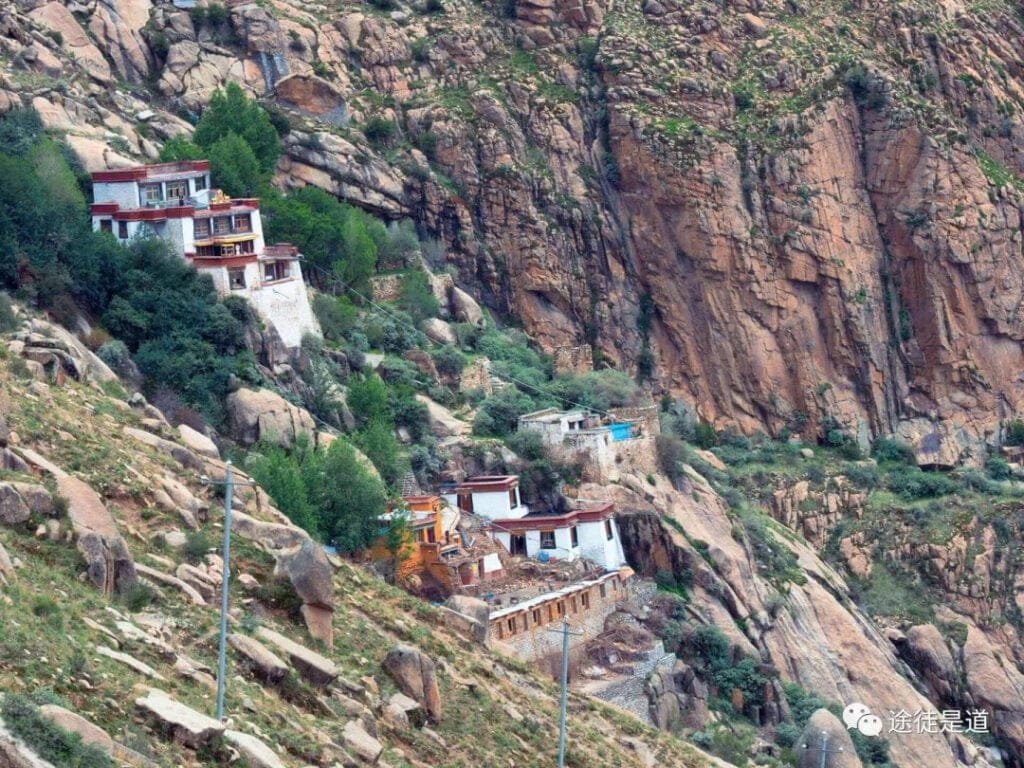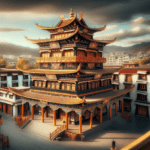.
Kyutsang Ritroe Hermitage: A Serene Sanctuary in the Heart of Tibet
Kyutsang Ritroe Hermitage sits peacefully on the scenic slopes of Sera Uze Mountain, tucked away behind the grand Sera Monastery in Tibet. At about 4300 meters high, this hermitage is a key part of the Gelug sect of Tibetan Buddhism and is closely connected to the Sera Monastery.
How to Get to Kyutsang Ritroe Hermitage:
If you want to visit Kyutsang Ritroe Hermitage, there are two main ways to get there. You can take a vehicle for a quicker and more comfortable trip close to the hermitage. Or, if you’re looking for a more immersive experience, a three-hour hike from the Sera Monastery not only challenges you physically but also offers a chance for spiritual reflection while surrounded by nature.
A Photographer’s Dream
Kyutsang Ritroe Hermitage not only serves as a place of spiritual solace but also appeals to photography enthusiasts with its fantastic views. From here, you can capture a remarkable perspective of the Potala Palace. Given the surrounding buildings’ clutter, using a telephoto lens is advisable to compress the depth of field. This approach accentuates the Potala Palace, making sure it stands out grandly against the backdrop. This technique allows you to snap a breathtaking and crisp image of one of Tibet’s most iconic edifices.
Kyutsang Ritroe Hermitage offers a peaceful escape, thanks to its unique location and spiritual significance. Visitors experience a journey that blends natural beauty with cultural richness, making it an essential destination for both spiritual seekers and photography enthusiasts.

Kyutsang Ritroe Hermitage: A Historical Sanctuary of Tibetan Buddhism
The Kyutsang Ritroe Hermitage, nestled on the eastern side of Sera Monastery and just three to four kilometres north of the sky burial site, offers a serene retreat. “Kyutsang” means a cave or secluded place. Revered figures like the Shang Lama, founder of Tsalpa Kagyu, and Tsongkhapa have graced this hermitage. Their handprints, still visible today, testify to their stay.
The Legacy of Kyutsang Ritroe
In later years, as Jey Dratsang Khenpo Jamba Menlang aged, his steward suggested he retire to Kyutsang Ritroe for spiritual practice, foreseeing the decline in the quality of reincarnated Lamas. Defying this, the Khenpo expressed his determination to be reborn again. He even requested to be reincarnated in the womb of Dorje Tandin Pamo, making it easier for his followers to find him. In 1791, a child born to Dorje was recognized as the Khenpo’s reincarnation.
The Growth of the Hermitage
Originally, Kyutsang Ritroe Hermitage started with only four monks. Over time, this number increased to 27 and then to 70. In its main hall, there was a tall gilded bronze statue of Maitreya Buddha, surrounded by statues representing four generations of living Buddhas, tall flesh-body stupas, and portraits of successive living Buddhas. They also displayed scriptures like the “Eight Thousand Verses” and the “Sutra of the Wise and the Foolish,” both written in gold powder. On the second floor, a life-sized gilded bronze statue of Avalokiteshvara stood among ancient texts from the Sakya and Gelug sects. Now, a new main hall with six columns has been built on the same spot, displaying replicas of these divine statues.
The Eastern Counterpart: East Kyutsang Ritroe
Just north of Kyutsang Ritroe lies its eastern counterpart, East Kyutsang Ritroe, established by Sera Monastery’s Gyayang Rosé in the late 18th century. Successive Phurchok living Buddhas managed this hermitage. Both the East and West Kyutsang Ritroes are perched on steep cliffs.
A Tale of Contrasting Fates
A well-known story from this area powerfully illustrates karma and its consequences. It recounts how a butcher, deeply moved by a sheep trying to bury the knife meant for its slaughter, renounced his sins. As a result, he was miraculously transported to a field, which later became a site for burning juniper incense. Inspired by this, a practitioner, curious about the outcome of his own leap of faith, jumped off a cliff but unfortunately met a tragic end. A stupa was erected at the spot where he fell. This tale highlights the profound impact of one’s intentions and actions.
Kyutsang Ritroe Hermitage, enriched with history and spiritual significance, stands as a beacon of Tibetan Buddhism. It offers deep insights into the faith’s firmly rooted beliefs and traditions.
Raka Drak: The Hermitage Carved with Horns
Raka Drak, which means “rock cave carved with a horn,” is rich in legend. The story goes that Tsongkhapa, hiding from envoys sent by Ming Dynasty’s Emperor Chengzu, took refuge in the cliffs on the west side of this location. Legend has it that Yama, the protector deity, carved an entrance into the meditation cave with his horn to meet the great master.
The Beauty of Lhasa from Above• The Appeal of Northern Suburbs’ Mountains:
The main attraction of these mountains wasn’t initially the flora, but rather the breathtaking view of Lhasa from these heights. Memorable hikes involve ascending from Kyutsang Ritroe, passing through fragrant grasslands, encountering charming wildflowers, and finally reaching the summit adorned with fluttering prayer flags. From this vantage point, the view of Lhasa is truly stunning.
Changing Times and Accessibility• Evolving Experiences:
What used to be a strenuous hike to the mountain’s summit to view Lhasa’s panorama can now be easily accessed by a car drive up the mountain, reflecting the changing times and increased accessibility.
The monasteries, Rakacha and Kyutsang, are more than just physical structures; they serve as repositories of rich stories, personal memories, and the spiritual heartbeat of Tibetan Buddhism. They remind us that the beauty and significance of a place are not just in its historical or religious importance but also in the personal connections and experiences we forge with them.















